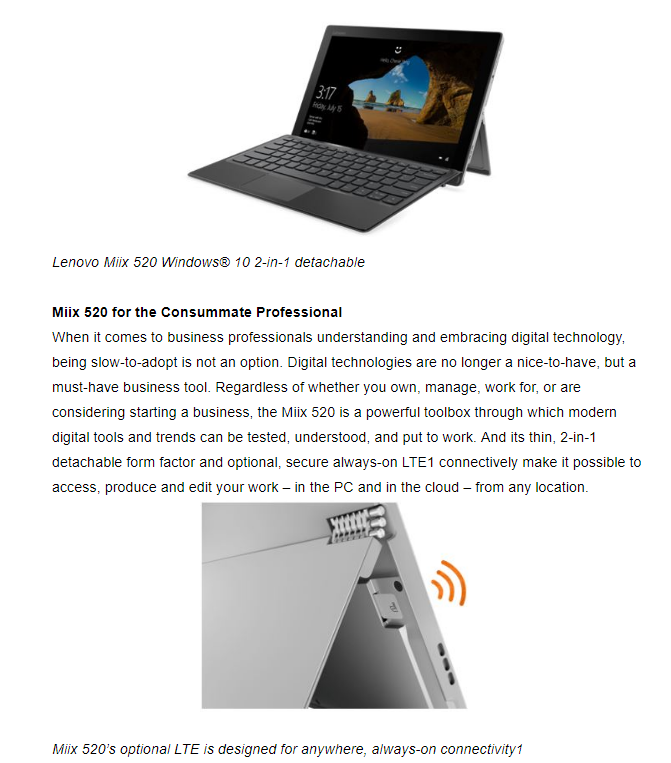Shots Fired as Qualcomm Bets on Always Connected Devices with Long Battery Life: Intel Responds
by Ian Cutress on December 5, 2017 5:00 PM EST
At the Qualcomm Snapdragon Technology Summit today, the majority of the keynote was aimed squarely at how a new product segment of ‘Always Connected PCs’ with all-day battery life will bridge the gap between the utility of a smartphone and the productivity of a PC. The critical take home message from Qualcomm, and the partners that showed devices at the event, was that by using a smartphone chip on a smaller PCB and an integrated modem, laptop designs could be stuffed with a battery and as long as it has the right OS and software combination, it will offer a better user experience than what is available currently. Qualcomm has extensively worked with Microsoft on creating a version of Windows 10 that works on their Snapdragon 835 SoCs, and is now ready to declare deployment.
Joining Qualcomm on the stage for the announcement were the key partners (from left to right):
- Jerry Shen, ASUS CEO: Announcing the ASUS NovaGo
- Kevin Lensing, CVP and GM of Client at AMD: Announcing Ryzen Mobile partnership
- Cristiano Amon, EVP Qualcomm Technologies
- Terry Myerson, EVP of Microsoft Windows and Devices: Announcing Windows 10 on ARM
- Gunther Ottendorfer, COO of Sprint: Reinforcing Connectivity Partnership
- Kevin Front, VP and GP of Consumer Systems HP: Announcing HP Envy x2
Cristiano Amon, executive vice president of Qualcomm Technologies and president of QCT, was joined on stage by senior executives from Microsoft, Asus, Sprint, HP and AMD announcing the new class of Always Connected PC, at Qualcomm’s second annual Technology Summit Tuesday, Dec. 5, 2017 in Maui, HI. Photo Source: Qualcomm Technologies, Inc.
Now creating a new product category that is successful is difficult. How many attempts at a tablet were there before the market warmed to them, for example. Or consider how many smart watches have come and gone since the inception. As bright as all the semblance of new technology is, the major incumbent in the notebook PC space also had something today.
Intel Responds
In a nutshell, Intel’s response was:
[Intel] has been powering always-connected PCs since their inception. Today, there are more than 30 business- and consumer-oriented Intel-based always-connected PCs available, offering the leading performance, a variety of connectivity options and price points, long battery life and thin and light form factor design.
The response is basically a ‘we’ve had always-connected PCs for years’. This is true: while normally focused on the business use case, laptops with LTE connectivity do exist from most of the major OEMs. This usually comes in the form of an add-in card and a business contract situation, although I personally have owned a number of laptops that do offer SIM card slots for this sort of functionality.
Intel is citing designs such as the HP ProBook 400 Series, Samsung’s Galaxy Book 12, the Lenovo ThinkPad L470, the Lenovo Miix 520, the Google Pixelbook, and the Mi Notebook Air, with more designs coming in 2018. Intel is also citing that it has modems in future devices capable of Gigabit LTE as well, along with its investments into 5G. Intel also cites that it has full compatibility with Windows and 64-bit software.

From Lenovo's Miix 520 website
So is what Qualcomm is doing new? Will it succeed? Truth be told, they are reinvigorating interest in this type of device, regardless of if it has already been around, and pushing it for other use cases. Intel has often pushed its devices for new use cases over the years, but this time it is a new silicon manufacturer playing the game in a slightly different way. The devices that come out, be it with a Qualcomm SoC or an Intel CPU with extra modem, are both going to have positives and drawbacks – Qualcomm is touting all-day battery life and instant screen-on without sleeping, while Intel goes for performance and compatibility.
Shots fired? The annual CES event in Las Vegas is happening in early January. I expect Qualcomm, Intel, and all the OEMs to be screaming about ‘Always Connected PCs’. It’s a fun time to be a consumer.
Related Reading
- Qualcomm Snapdragon Tech Summit: Day One Live Blog
- ASUS Announces the NovaGo (TP370): A Snapdragon 835 based Windows 10 PC
- Microsoft Launches Windows 10 On ARM: Always Connected PCs
- The Qualcomm Snapdragon 835 Performance Preview
- Microsoft and Qualcomm Collaborate to Bring Windows 10 & x86 Emulation to Snapdragon Processors











45 Comments
View All Comments
Someguyperson - Tuesday, December 5, 2017 - link
"Let just hope they continue allow usage disconnected."It's called Airplane Mode. It's only been around for a decade or two.
rocky12345 - Tuesday, December 5, 2017 - link
For me I do not need always connected device like a laptop. If I do I just tether my smart phone or make my phone a wifi hot spot and that allows me to get my laptop on the internet if I am in a remote spot without any other form of internet. I also do not want or need to have another monthly bill form my ISP just so I can have my laptop go on the internet.This crap about everyone having to have all of their devices hooked up to Facebook 24/7 is plain dumb. Like I said if I need my laptop on the internet that is one of the reasons I have a device that already does that being my smart phone...For myself this is just a waste of time and money but there are probably others that will find it an asset I guess.
rocky12345 - Tuesday, December 5, 2017 - link
Just wanted to add don't even get me started on this x86 emulation trudge. People will buy into it thinking it will be just like having a real x86 device only to find out that most software will either run very slow or not at all & if you want to fire up a game well most likely forget that since the hardware will be way to slow and the game probably will just refuse to run or flat out crash.Someguyperson - Tuesday, December 5, 2017 - link
I don't think anyone would think of gaming on a fanless device. Do people expect to game on the fanless MacBook? No, you need a discrete GPU or an APU to do any moderately stressful gaming.rocky12345 - Wednesday, December 6, 2017 - link
YEs a sane person would probably not try to game on one of these devices but there are a lot of people out there that will try to and then be upset that because they just spent $600-$700 on a device they most likely expect it to perform at that level as well.inighthawki - Wednesday, December 6, 2017 - link
Well I don't think anyone is going to purchase this type of device with the idea of running demanding 3D games, but it wouldn't be unreasonable to expect some very popular and less demanding games to run, like league of legends. If a game like that cannot run at adequate performance (where it normally would on a standard [low end] x86 device), there will be some upset people. I don't think this would be unreasonable for a person to think at all.masouth - Thursday, December 7, 2017 - link
"Well I don't think anyone is going to purchase this type of device with the idea of running demanding 3D games..."You are speaking from YOUR tech knowledge and not that of the general tech-buying but tech-ignorant consumer. I get asked entirely too many questions along the lines of "I play new FPS games on my 8600 GT but it's only got 512mb of RAM so I was looking to upgrade to a GT 710 because it's got 2gb so it will be crazy fast, right? o.O
Personally, I wouldn't even bother loading up a modern FPS on either of those because I would never get the resolution/ settings/ frame rates that I would be happy with but that's the reality that many people live with (integrated intel/ entry level card/ old card) and yet many of them expect if they spend at least XXX amount of dollars then they should be able to get what they want. The dollar amount changes depending on the person but the expectations always seem to be above the reality of their budget.
Never, and I mean NEVER, underestimate consumers ability to believe the amount of money spent equals performance in whatever they want it to perform in. I have zero doubt there would be a not insignificant number of people that would buy this and then expect to play Battlefield 1 butter smooth at 4k.
Amandtec - Thursday, December 7, 2017 - link
If you you mostly use Office and Email (many people) and want a light device with 20 hours battery, an iPad and a mobile data connection for $600 then you are the target market.Alistair - Tuesday, December 5, 2017 - link
I was hoping to see ARM desktops. Not really interested in more overpriced laptops.Surface laptop with snapdragon 845 and phone call and messaging support?
HStewart - Wednesday, December 6, 2017 - link
"I was hoping to see ARM desktops. Not really interested in more overpriced laptops."Are you really serious in ARM desktop - that sounds crazy and saying that laptops are overprice - I guess you never had a computer from the 90's or early 2000's - I remember paying $3500 for huge desktop that a $100 ATOM today would blow away
"Surface laptop with snapdragon 845 and phone call and messaging support?"
Microsoft had this before - it was called "Windows RT" and it failed. Not sure if had Phone support